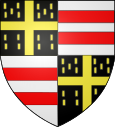Taulignan
| Taulignan | ||
|---|---|---|

|
|
|
| region | Auvergne-Rhône-Alpes | |
| Department | Drôme | |
| Arrondissement | Nyons | |
| Canton | Grignan | |
| Community association | Enclave des Papes-Pays de Grignan | |
| Coordinates | 44 ° 27 ' N , 4 ° 59' E | |
| height | 203-760 m | |
| surface | 34.65 km 2 | |
| Residents | 1,677 (January 1, 2017) | |
| Population density | 48 inhabitants / km 2 | |
| Post Code | 26770 | |
| INSEE code | 26348 | |
| Website | www.mairie-taulignan.fr | |
 The lez at Taulignan |
||
Taulignan is a french commune with 1,677 inhabitants (at January 1, 2017) in the department of Drôme in the region Auvergne Rhône-Alpes . It belongs to the canton of Grignan and its municipal association Pays de Grignan .
geography
Taulignan is located at the foot of the wooded Montagne de la Lance mountain range , which belongs to the Provencal Prealps , about 30 kilometers southeast of Montélimar , seven kilometers northwest of Valréas and 6.4 kilometers northeast of the canton capital Grignan , between the neighboring communities of Montbrison-sur-Lez im Southeast and Salles-sous-Bois to the northwest. The Lez flows east, the Berre flows northwest of the town center through the municipality.
history
Taulignan is a medieval town with a fortified center. In the 12th century it was the seat of a seigneurie that belonged to the barony of Montauban-sur-l'Ouvèze . Bertrand de Taulignan sold the Seigneurie in 1295 to the Count of Valentinois , Aymar IV. De Poitiers. Until the French Revolution (1789-1799) the village was owned by different families. The last lady of the castle was the widow Nicole de Lamoignon de Senozan († May 1794), a sister of Chrétien-Guillaume de Lamoignon de Malesherbes (1721-1794). She was imprisoned in 1793 during the French Revolution together with her friend, Princess Élisabeth Philippine Marie Hélène de Bourbon (1764–1794), and sentenced to death on the scaffold . In the same year the castle was razed. It had made up about a third of the development inside the city's fortification walls. In addition, Taulignan received the status of a municipality in 1793 and the right to local self-government in 1801.
| year | 1821 | 1836 | 1851 | 1911 | 1921 | 1936 | 1954 | 1975 | 1990 | 2016 |
|---|---|---|---|---|---|---|---|---|---|---|
| Residents | 1,885 | 2,202 | 2,349 | 2.017 | 1,581 | 1,272 | 1,046 | 1,202 | 1,586 | 1,697 |
The population increased at the beginning of the 19th century and reached its peak in 1851 (2349), at the beginning of the 20th century it fell sharply. Taulignan had the fewest inhabitants in 1954 (1046), after which the number of inhabitants rose again slightly.
economy
In the 19th century the parish grew thanks to the silk industry , which employed over 400 workers. Today there is a silk museum on site that commemorates that time.
The vineyards of the place are in the wine-growing area of the southern Rhône valley . The wines may be marketed under the designation of origin Côtes du Rhône and the qualitatively stricter Côtes du Rhône Villages .
Web links
Individual evidence
- ↑ a b Official website of the CC Pays de Grignan ( Memento of the original from January 11, 2016 in the Internet Archive ) Info: The archive link has been inserted automatically and has not yet been checked. Please check the original and archive link according to the instructions and then remove this notice. (French) Retrieved October 7, 2012.
- ^ Taulignan on annuaire-mairie.fr (French) Retrieved March 19, 2010.
- ^ Taulignan on cassini.ehess.fr (French) Retrieved March 19, 2010.
- ↑ Taulignan on annuaire-mairie.fr (French).

